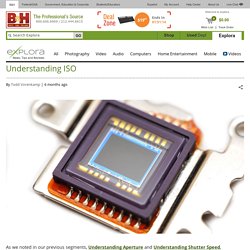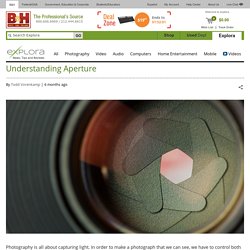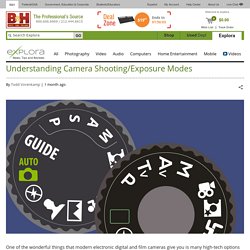

Terri Weifenbach at photo-eye Gallery. Keith Carter at photo-eye Gallery. Julie Blackmon at photo-eye Gallery. Artist Talk with Julie Blackmon (2008) - Snow Day, 2008. Artist Talk with Julie Blackmon (2008) - Snow Day, 2008. Artist Talk with Julie Blackmon (2008) - Power of Now, 2008. Julie Blackmon at SCAD Atlanta. Matthew Pillsbury. Photography: Altering Image Size. Aperture Shutter Speed and ISO, Photography 101. Digital Photography 1 on 1: Episode 16: Exposure: Adorama Photography TV. Understanding ISO. As we noted in our previous segments, Understanding Aperture and Understanding Shutter Speed, photography is the capture of light on a photosensitive surface, be it film or a digital sensor.

In order to expose a photograph, we have to control the number of photons that connect with the image surface, as well as control the sensitivity of that surface to the light. We compared aperture to the eye's iris that opens and constricts the diameter of its opening to limit the amount of light allowed into the eye. Understanding Shutter Speed. As we said in our last segment, Understanding Aperture, photography is all about capturing light.

In order to expose a photograph, we have to control the amount of light that is exposed to a photosensitive surface, as well as control the sensitivity of that surface to the light. We compared aperture to the eye's iris that opens and constricts the diameter of its opening to limit the amount of light allowed into the eye. ISO is similar to the sensitivity of the rods and cones at the back of the eye. And finally, shutter speed is akin to the duration of time your eye is open to take in the light. In Part Two of this three-part series, we will discuss shutter speed.
Shutter Speed Shutter speed is a measurement of time that a camera's shutter is open—allowing light, usually after it has passed through a lens and through the aperture diaphragm, to strike a photosensitive surface, like film or a digital sensor. Shutter speed values comparison Photographs © Todd Vorenkamp. Depth of Field. Understanding Aperture. Photography is all about capturing light.

In order to make a photograph that we can see, we have to control both the amount of light that is exposed to a photosensitive surface, be it film or a digital sensor, and also control the sensitivity of that surface to the light. In this three-part series, we will discuss light and how a camera and lens combine to control exposure. Exposure can be defined as the amount of light that falls onto the camera's light-sensitive surface. In any given scene, regardless if there is natural or artificial light being emitted, there is a measurable amount of light that illuminates your subject. Aperture Priority.
Crop Sensors vs Full Frame. Tv Mode - video tutorial. Understanding Aperture. Aperture Priority. Basic metering in photography. Too many photographers rely solely on their camera’s built in light meter to determine exposure (F-stop, ISO and shutter speed combination).

When they look at their digital files, or get their prints back from the photo lab (if they still play with film) they wonder why their prints are not all correctly exposed. To understand why this happens it is important to understand the basics of metering and how the camera sees and processes information. Camera meters, when used correctly, provide proper exposure readings which yield a full tonal range on the negative or digital file. That said, they cannot think on their own. All reflective light meters, including your camera’s meter are calibrated to give you an average reading of 18% grey (middle grey) on EVERY single shot. 18% grey (approx.) But what happens when there isn’t a wide variety of tones for the camera meter to average out? Camera Modes. Modes on your dSLR.
Understanding Camera Shooting/Exposure Modes. One of the wonderful things that modern electronic digital and film cameras give you is many high-tech options for your image making.

One of the horrible things that modern electronic digital and film cameras give you is many high-tech options for your image making. Sometimes, confusion ensues. And, very often, confusion starts with the camera’s modes. Adding to the confusion, a little bit, is the fact that not all camera manufacturers agree on how to label similar modes. [Hi, Canon! If you haven’t done so already, I recommend reading these articles on aperture, shutter speed, and ISO.
A final note: If you have been reading my articles on the B&H Photo website, you already know my thoughts on “proper, balanced, best,” or “correct” exposure. Modes Luckily for you, the photographer, and me, the writer, the modes are basically all the same, no matter what you choose to call them or how they are labeled on your camera. Programmed Auto / Program Mode (P)